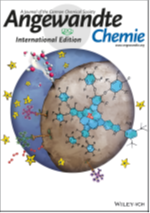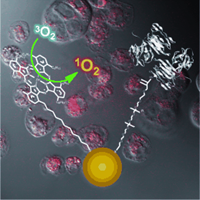Molecular Design
| Responsible | Ángela Sastre Santos |
| Website | http://quimicaorganica.umh.es |
RESEARCH SUMMARY
Our principal objective is the synthesis and supramolecular organization of electroactive systems based on phthalocyanines (Pcs) and dicetopyrrolopyrroles (DPPs) as artificial Photosynthetic Systems, for molecular Photovoltaic and Anticancer Treatment. Pcs are porphyrin analogues with, generally, planar structure and high conjugation of the central ring (18 π-electrons). They present interesting properties for application in photovoltaic cells, especially strong absorbance in the visible and near infrared radiation region and high thermal and chemical stabilities. On the other hand, DPPs possess exceptional absorbance properties in the 500-600 nm region, strong fluorescent performance besides a great stability. A common feature of DPP-based materials is their relatively high oxidation potential, leading to high-energy charge-separated states when combined with acceptor systems and correspondingly high voltages are obtained in solar cells. For these reasons DPPs, either as polymers or as single molecules, are being investigated as active layer on different OPV devices.

Phthalocyanine as Bioinspired Model for Chlorophyll f.
RESEARCH LINES
Line 1: Preparation of Multichromophoric Donor-Acceptor Ensembles as Light Harvesting Systems for Photosynthetic Energy Conversion
Our objective is the preparation of donor-(acceptor)n [D-(A)n] or aceptor-(donor)n [A-(D)n] systems composed of phthalocyanines and with different kind of electroactive system such as DPP, pyrene, PDI, C60, BODIPY, carbon nanotubes, graphene and MoS2 and to check their ability in axial and peripheral configurations to get long life charge separated states for photosynthetic energy conversion. We will check different estrategies to conect Pcs to doped N-graphene and other semiconductor 2D materials as MoS2. We will choose substituents in the phthalocyanine that could give at the macrocycle either a donor or and acceptor character.
Line 2: Preparation of Phthalocyanines and Diketopirrolepyrroles Systems for MOFs and SURMOFs organization
Pcs and DPPs exhibit a great potential as novel linkers for MOFs. They present different properties that made them a target for the generation of new innovative MOFs. Pcs and DPPs are easily functionalized, they are symmetric allowing the generation of crystalline structures, they have a lot of delocalized π electrons, they are optically active, and they can also generate oxidative species upon excitation. However, till now, Pcs and DPPs have been scarcelly incorporated in MOFs and SURMOFs structures.

Zn-Si-Pc SURMOF grown on SAM-modified Ag and its absorption spectrum (blue arrow corresponds to Si-Pc solvated linker absorption maximum).
Line 3: Synthesis of organic materials for photovoltaics
Our group is actively working in the incorporation of Pcs and DPPs as photoactive components in different solar cell devices: p-n organic solar cells, as non-fullerene acceptors in bulk heterojunction solar cells, as photosensitisers in dye-sensitised solar cells, in perovskite solar cells, and also as interlayers acting as either electron- or hole-transporting materials. As a previous step, we investigate the photophysical properties of Pcs and DPPs regarding to photoinduced energy and/or electron transfer.

Line 4: Synthesis of Phthalocyanines as Metallodrugs
This line includes the synthesis of cyclometalated gold and platinum complexes conjugated with metallophthalocyanines that will be used as anticarcinogenic drugs. Texaphyrin-phthalocyanine and phthalocyanine analogs will also be prepared that can serve as intercalating agents for DNA quadruplexes. Once the derivatives have been synthesized, the pharmacological studies will be carried out in the research groups of collaborators who are within the network of excellence in which we are involved called “Multifunctional Metalpharmaceuticals for Diagnosis and Therapy (RED2018‐102471‐T)”.

Phthalocyanines as photosensitizers for photodynamic therapy.
M. J. Álvaro-Martins, J. G. Sánchez, G. Lavarda,.D. Molina,. J. Pallarès, T. Torres, L. F. Marsal, Á. Sastre-Santos
Subphthalocyanine-Diketopyrrolopyrrole Conjugates: 3D Star-Shaped Systems as Non-Fullerene Acceptors in Polymer Solar Cells with High Open Circuit Voltage
Chem Plus Chem. (2021)
A. A. A. Torimtubun, J. Follana-Berná, J. G. Sánchez, J. Pallarès, Á. Sastre-Santos, and L. F. Marsal
Fluorinated Zinc and Copper Phthalocyanines as Efficient Third Component in Ternary Bulk Heterojunction Solar Cells
ACS Applied Energy Materials. (2021)
J. Follana-Berná, R. Farran, W.Leibl, A. Quaranta, Á. Sastre-Santos and Ally Aukauloo
Phthalocyanine as Bioinspired Model for Chlorophyll f Containing Photosystem II Pushing Photosynthesis in the Far-Red
Angew. Chem. Int. Ed. (2021)
I. K. Sideri, Y. Jang, J. Garcés-Garcés, Á. Sastre-Santos, R. Canton-Vitoria, R. Kitaura, F. Fernández-Lázaro, F. D’Souza and N. Tagmatarchis
Unveiling the photoinduced electron-donating character of MoS2 in covalently linked hybrids featuring perylenediimide
Angew. Chem. Int. Ed. (2021)
I. Papadopoulos, M. J. Álvaro-Martins, D. Molina, P. M. McCosker, P. A. Keller, T.Clark, Á. Sastre-Santos and D. M. Guldi
Solvent-Dependent Singlet Fission in Diketopyrrolopyrrole Dimers: A Mediating Charge Transfer versus a Trapping Symmetry-Breaking Charge Separation
Adv. Energy. Mater. 10, 2001496 (2020)
P. Huang, A. Hernández, S. Kazim, J. Ortiz, Á. Sastre-Santos, S. Ahmad
Molecularly engineered thienyl-triphenylamine substituted zinc phthalocyanine as dopant free hole transporting materials in perovskite solar cells
Sustainable Energy & Fuels. 4, 6188-6195 (2020)
L. Martín-Gomis, S. Seetharaman, D. Herrero, P. A. Karr, F. Fernández-Lázaro, F. D’Souza, and Á. Sastre-Santos
Distance Dependent Electron Transfer Kinetics in Axially Connected Silicon Phthalocyanine-Fullerene Conjugates
Chem. Phys. Chem., 21, 2254-2262 (2020)
I. Papadopoulos, D. Gutiérrez-Moreno, P. M. McCosker, R. Casillas, P. A. Keller, Á. Sastre-Santos, T. Clark, F. Fernández-Lázaro and D. M. Guldi.
Perylene-Monoimides: Singlet Fission Down-Conversion Competes with Up-Conversion by Geminate Triplet-Triplet Recombination
J. Phys. Chem. A 124, 5727–5736 (2020)
E. J. Canto-Aguilar, D. Gutiérrez-Moreno, Á. Sastre-Santos, D. Morikawa, M. Abe, F. Fernández-Lázaro, G. Oskam and S. Mori
Identification of the loss mechanisms in TiO2 and ZnO solar cells based on blue, piperidinyl-substituted, mono-anhydride perylene dyes
Electrochimica Acta 355; 136638 (2020)
R. Haldar, Z. Fu, R. Joseph, D. Herrero, L. Martín-Gomis, B. S Richards, I. A. Howard, Á. Sastre-Santos and C. Wöll
Guest-Responsive Polaritons in Porous Framework: Chromophoric Sponges in Optical QED Cavities
Chem. Sci. 11, 7972-7978 (2020)
Hacia la Síntesis de Moléculas Avanzadas para la Generación de Energía. CTQ2017-87102-R. Funding agency: Ministerio de Economía, Industria y Competitividad. Duration: 01-01-2018 – 30-09-2021.
PI: Ángela Sastre Santos
Hacia la Síntesis de Moléculas Avanzadas para la Generación de Energía. CTQ2017-87102-R. Funding agency: Ministerio de Ciencia e Innovación. Duration: 01-01-2018 – 30-09-2021.
PI: Ángela Sastre Santos
Moléculas y Polímeros Conjugados Innovadores para la preparación de Células Solares Orgánicas e Híbridas y para aplicación en Optoelectrónica. CTQ2014-55798-R. Funding agency: Ministerio de Economía, Industria y Competitividad. Duration: 01-10-2015 – 30-09-2018.
PI: Ángela Sastre Santos
Síntesis, Caracterización y Autoorganización de Sistemas Electroactivos para la Construcción de Células Solares Orgánicas. CTQ2011-26455/BQU. Funding agency: Ministerio de Economía, Industria y Competitividad. Duration: 31-12-2011 – 31-12-2014.
PI: Ángela Sastre Santos
Diseño y Síntesis de Sistemas Moleculares y Supramoleculares Electroactivos para aplicaciones Optoelectrónicas basadas en Transferencia Electrónica Fotoinducida. CTQ2008-05901/BQU. Funding agency: Ministerio de Economía, Industria y Competitividad. Duration: 31-12-2008 – 31-12-2011.
PI: Ángela Sastre Santos
